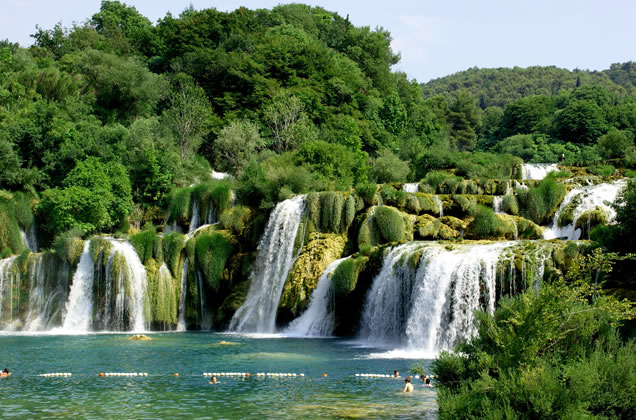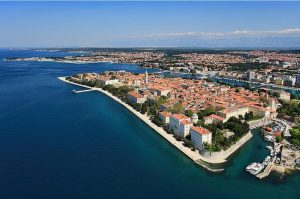Trips around Pakostane
Nearby Pacostane are 2 real authentic and historic citys: Zadar and Sibenik. They offer an interesting insight into the Croatian cultural heritage. Also the nature surrounding Pacostane is beautiful. Cornati National Park, a group of circa 140 islands and Krka National Park, named after the river Krka that it encloses, are the 2 best examples.
Zadar
The old center of Zadar is siuated on a peninsula and can be reached by footbridge. The church of St. Donatus, the Roman Forum and the St. Anastasias Cathedral are worth visiting.
On the avenue on the peninsula ou can find 2 extraordenary works of art. The Sea organ and a monument working with solar power called: “greatings to the sun”. <div=”” class=”clearfix”> </div=””>
Sibenik
This region is characterized by limestone mountain crests, small valleys (Gornje and Donje polje) and plateaus which are the base for agriculture. Vegetation is mainly spruce in the hinterland and maquis on the coastal areas and on the islands. The Šibenik region has a characteristic. Mediterranean climate with hot summers cooled by the maestral breeze, and dry winters.
 This region is characterized by limestone ridges, small valleys (Gornje and Donje polje) and plateaus, which form the basis for agriculture. Vegetation is mainly spruce in the hinterland and maquis on the coastal areas and on the islands. The Šibenik region has a characteristic and Mediterranean climate with warm summers cooled by the maestral wind and dry winters.
This region is characterized by limestone ridges, small valleys (Gornje and Donje polje) and plateaus, which form the basis for agriculture. Vegetation is mainly spruce in the hinterland and maquis on the coastal areas and on the islands. The Šibenik region has a characteristic and Mediterranean climate with warm summers cooled by the maestral wind and dry winters.
Šibenik, the oldest native Croatian city on the Adriatic, is located in the most protected natural harbour, in the centre of the eastern coast of the Adriatic Sea, at the mouth of the beautiful Krka River, at the sources of Croatia’s rich history, probably in the place where some of the original Croatian settlers first saw the blue sea, as capricious as it is beautiful that both protected and defended them, fed and took care of them for as long as they could remember. Today Šibenik has 47,274 inhabitants (2011) and is the capital as well as the cultural, educational, administrative and economic centre of the County of Šibenik and Knin.
Cornati National Park
Tourism started slowly appearing on the Kornati during the Seventies. That’s the time when the biggest changes in the lives of the Kurnatari occurred, too, and the changes had a strong influence on the appearance of the Kornati. The younger generations went to schools to cities, where they also found jobs. Understandably, that resulted in the neglect of sheep herding and agriculture in general on the Kornati.

The only crop cultivated on overgrown fields today is olive because it requires the least effort. Nevertheless, it’s far from being as abundant as it used to be. There is only one small vineyard left on the Kornati, in a field above Špraljin stan near Suha punta.
With the mass use of motors on boats and particularly with the appearance of fast motorboats, the Kornati became much more accessible. You can spend less time on the Kornati farming – you can go to the Kornati and return home in one day. However, the Kurnatari turned to tourism and adapt their Kornati houses for tourists. There are about twenty restaurants opened on the islands and the Kornati became a strong brand, attracting many yachtsmen and holiday-makers.
Krka National Park
Krka National Park lies within Šibenik-Knin County, and covers a total area of 109 km² of the loveliest sections of the Krka River, and the lower course of the Čikola River.  The national park is a vast and primarily unaltered area of exceptional natural value, including one or more preserved or insignificantly altered ecosystems. The purpose of the park is primarily to serve science, culture, education and recreation, while tourism activities have also been introduced for its visitors.
The national park is a vast and primarily unaltered area of exceptional natural value, including one or more preserved or insignificantly altered ecosystems. The purpose of the park is primarily to serve science, culture, education and recreation, while tourism activities have also been introduced for its visitors.
Including the submerged part of the river at the mouth, the Krka River is 72.5 km long, making it the 22nd longest river in Croatia. It springs in the foothills of the Dinara mountain range, 2.5 km northeast of Knin. With its seven waterfalls and a total drop in altitude of 242 m, the Krka is a natural and karst phenomenon. The travertine waterfalls of the Krka River are the fundamental phenomenon of this river.

